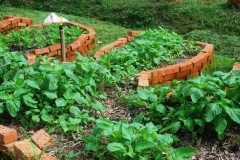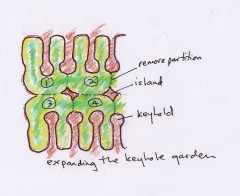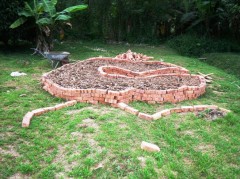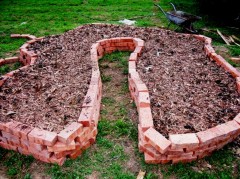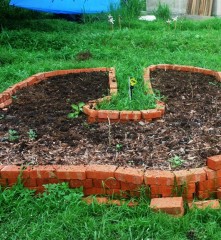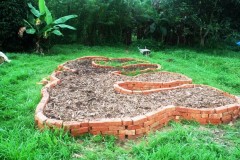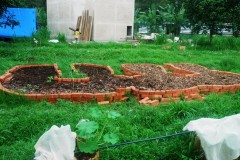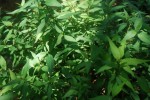Oct 28, 2009
Expanding Keyhole Raised Beds - Harvest Time
The Bayam Pasir (wild amaranth), a personal favourite is ready for harvest. And to be frank, I did not even visit the bed once since we sowed the seeds three weeks ago. Nobody did any weeding, the farm hand just turn on the sprinkler occasionally when the compost was dry to the 'poked-finger' and once a week sprayed some compost tea.
Note: Bayam Pasir draws unhealthy levels of nitrates from chemical NPK fertilisers. Always use low N compost. Avoid eating too much 'modern' hybrid vegetables grown conventionally. Always chose vegetables grown on compost such as Grace Cup, even though they may not be certified. Choose organic vegetables that are non-'modern' hybrid (heritage or heirloom) and slow growing, and grown on compost too. Talk to your farmer.
Avoid buying from 'organic' corporate farmers. They will use high NPK 'organic' fertilisers, high N demanding vegetable varieties (faster growing and larger), etc. Too much of these vegetables may cause imbalances in our bodies.
19:15 Posted in Permaculture | Permalink | Comments (0) | Tags: : keyhole beds, raised beds, organic vegetables, no-dig garden, permaculture
Sep 24, 2009
Expanding Keyhole Raised Beds
One of the biggest headaches in organic vegetable farming in Malaysia is weeds. The weeds just grow too fast; napia, as an extreme example can reach 5 feet in 30 days. And do not forget lalang! Some conventional farmers here lay the entire planting area with plastic sheeting. Heck, some commercial organic farms do the same!
Weeding is back-breaking work especially for those new retirees who dream of establishing an organic farm: your back is going to give up before your first harvest.
Raised bed is one answer. For the new farmer, you can use an expandable raised bed design that we have developed to suit our local conditions and needs:
1. To increase your production capacity as your sales increases.
2. To reduce labour costs
3. To reduce weeding costs
4. To reduce dependence on machinery
5. To ensure long term soil fertility
6. To eliminate digging and tilling of the soil
Soil fertility has not been a problem with us using raised beds. Earthworm population remains high. And replanting by crop rotation and continuous adding of compost into the raised beds keeps production at optimum levels harvest after harvest.
This is the expandable raised bed design developed by us based on designs developed by permaculturists. The keyhole and curved edging allows for maximum utilisation of space, and it looks good compared to straight rows of beds.
(Click for close-up):
Bed One
Close up of bed One. You can reach half of the bed from within the keyhole and the other half from the outside edge of the raised bed.
How about that? After one month, still no weeds (well, if you can call those few pathetic sprouts, weeds). Notice how the top layer has changed to a darker color over the month. This is indicative of earthworm activity.
Adding Bed Two after one month
It is preferable to use stones or discarded bricks and concrete blocks to make your raised bed walls ( I make it a habit nowadays to stop at demolition and construction sites to pick up old bricks, etc). It is a one-time investment in labour and costs, and lasts forever as opposed to bamboo, timber, etc. Remember that in Malaysia, labour costs are a large component of your production cost and you do not want to incur labour costs repeatedly for the same thing.
(Click for close-up)
Another view: Beds One and Two, expanding laterally.
Now that we have demonstrated that even after 30 days there is no weed problems, we have started sowing Bed One with 3 different varieties of vegetables and in Bed Two, a wild amaranth (bayam pasir), a personal favourite. Go for heritage seeds when you first start out. They will do very well on compost and raised beds, have less disease and insect problems and will be very forgiving of your mistakes.
20:28 Posted in Permaculture | Permalink | Comments (2) | Tags: keyhole beds, raised beds, organic vegetables, no-dig garden, permaculture
Apr 27, 2009
No-Dig Herb And Vegetable Garden - Report No. 2
The No-Dig, Lazy-Man herb and vegetable gardens are turning out very well. The plants are luxuriant and really a joy to behold in the mornings with their fragrances and buzy insects. Part of the reason is the use of our "Qi Compost" which seems especially well suited to herbs and the slower growing varieties of vegetables. There's so little work involved in maintaining the gardens, it's amazing!
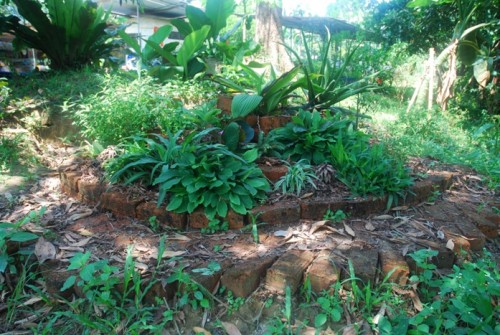

Here are some of the herbs and vegetables growing at the lazy-man's gardens:
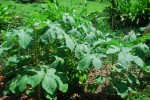
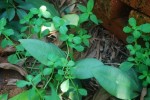
18:38 Posted in Permaculture | Permalink | Comments (0) | Tags: permaculture, no-dig garden, lazy-man garden
Mar 14, 2009
Mandala, Bird's Nest and Snake-Shaped Pond
Mandala Garden and Bird's Nests
The twain can meet. Here's how:
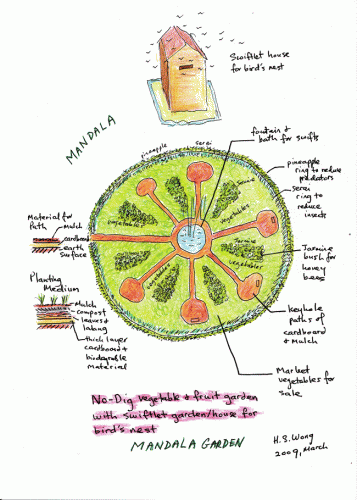
I intend to build this at the farm. The mandala shall be 40 ft across. Swifts need a roving area in front and a large water source, and that will be the mandala's centre.
The animals produce lots of gnats and mosquitoes during the wet season and swifts eat them, thus doing the farm a service.
The mandala in front will provide a conducive environment for the swifts and enhance production of the edible nests. One house will produce up to 40 kg of nests; selling for rm4,000 per kg, that's rm160,000 per house per annum.
Semi-Intensive Snake-Shaped Fish Pond
Commercial fish ponds pollute the environment and are energy intensive. Because of intensive farming, the ponds use pumps and motors to aerate. Waste are typically just discharged to the environment.
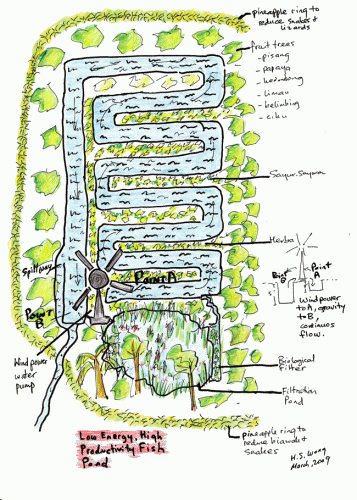
This snake shape pond will use gravity to flow the water from Point A to Point B, from Point B a wind powered pump will lift up the water to the filtration pond which shall comprise mechanical and biological filtration to clean the water. Throughout the length of the snake-shaped pond will be surface disruptors to aerate, as the water gravity-flows throughout the length of the pond.
My bank which advertises that they are 'friends' of farmers told me my mandala and bird's nest, and snake-shaped pond, is not agriculture, it's hobby farming!
Looks like I have to sell off some asset to fund these ideas. Eco-solutions have to make financial sense for farmers to adopt them. I think these two ideas can produce good income without damaging the environment.
22:03 Posted in Permaculture | Permalink | Comments (7) | Tags: permaculture, mandala garden, no-dig garden, bird's nest, swiftlets, seriti, walet, aquaculture








